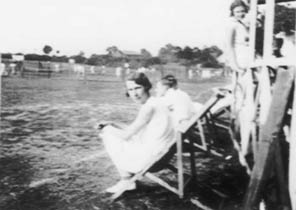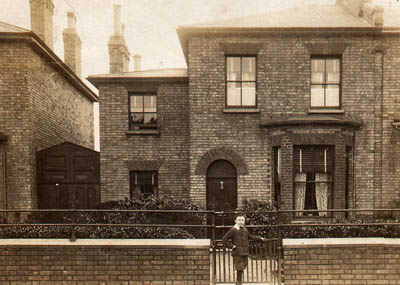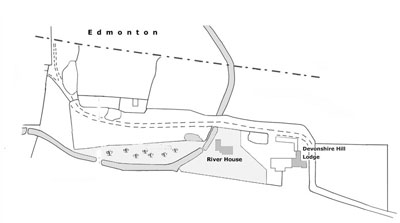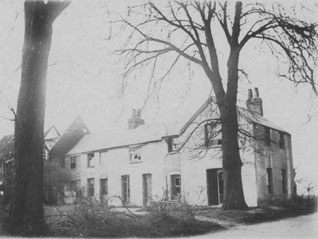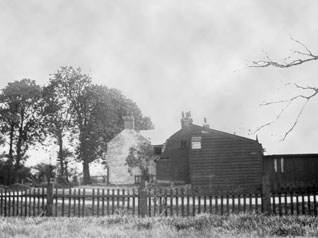|
UPDATE No 56 |
|||||||
|
DEVONSHIRE HILL FARM |
|||||||
|
From the 1890s the South family leased Devonshire Hill Farm (formerly Clay Hill Farm) from the New River Company including the fields extending over some 30 acres to the west of the South Pottery in White Hart Lane. By the 1920s most the fields were let out as playing fields to a number of sports clubs. A refreshment pavilion had been erected by Samuel South(2) for the use of the tenants but some clubs provided their own facilities. In her memories, his daughter Gladys, recalled that her elder sister, Hilda, '...ran the large canteen sort of building on the sports fields beside the potteries'. By the time that the New River Company sold the land to Wood Green UDC in 1930, 40 tennis clubs were leasing grass tennis courts in addition to football, cricket and hockey pitches. Some of the clubs renewed their leases with the Council and others moved away.
One of the South tenants that relocated in 1930 (to Winchmore Hill) was the Polygon Cricket & Tennis Club founded in 1923 by Syd Walker and fellow students of the Northern Polytechnic Night School. His son, Colin, has provided photographs of club members during its time at the Devonshire Hill Farm playing fields. |
|||||||
|
SOUTH FAMILY |
|||||||
|
When Joseph South emigrated to New Zealand in 1874 with his second wife, Mary Ann, his son, Samuel(1) then aged 21, of the first marriage to Emma Bright, remained in the UK along with his older surviving siblings, Ann (aged 29), Joseph junior (aged 24) and Solomon (aged 23). Update 45 described the contact with Chris Haines, the great great grandson of Ann South (1845-1898) who had married William Passaway in 1869. Chris has since reported on subsequent research establishing more precisely the date of Ann's birth as 24 November 1845 in Barley and that the family surname was registered as Bysouth on the birth certificate. Over several generations the names of South and Bysouth had been interchangeable (Update 26) but it had been thought that by the time of Joseph's marriage to Emma the surname of South had been adopted by the branch of the family. All other certificates concerning Joseph's family are registered in the name of South. In 2009 contact was made with Bruce Rix, a great grandson of Joseph South junior (1850-1897). Joseph married Sarah Webb in 1870. There were two daughters from the marriage, Emily (b 1871) and Florence (b 1874), and after his death in 1897, following a fall at his Edmonton brickfield, the family moved to Northumberland Park in Tottenham. Florence married Albert Rix, a journalist, in 1899 and set up home next door to her mother. Their son, Reginald, was born in 1900 and a daughter, Margaret, in 1910. Bruce Rix is the son of Reginald and his marriage to Phyllis Stock. Emily South married Charles Hurd in 1901 and the Rix and Hurd families continue to own property in Edmonton that was part of the estate of Joseph South.
Contact with a descendant of the remaining sibling, Solomon, also was achieved in 2009 when Laura Newby approached Christopher South as a result of his weekly broadcast on Radio Cambridgeshire. Solomon South (1851-1926) married Eliza Berdnes, and the 1901 census records 7 children of the marriage including Walter (b 1894) who married Daisy Canham in 1919. Their daughter Joan, the mother of Laura, was born in 1921. |
|||||||
|
DEVONSHIRE HILL LODGE - A MURDER MYSTERY SOLVED |
|||||||
|
Devonshire Hill Lodge (formerly Clay Hill Lodge) was the neighbouring dwelling to River House in Devonshire Hill Lane. The Lodge was demolished in the early 1900s and the site had been absorbed into neighbouring property by the time River House was purchased by Samuel South(1) in 1912. His son, Samuel South(2), who occupied River House from 1917, sold the former site of Devonshire Hill Lodge to Whitbread, brewers, in 1927 and the White Hart Public House was erected on the plot. In 1998, having been acquired by the Metropolitan Housing Association, the public house was converted into apartments and re-named Andy Ludlow House.
Davidson was mentally deranged and the reported detail provides some insight into the attitude towards and treatment of such disability. Reported nationally, the murder gave rise to lurid headlines; 'MURDER BY AN IDIOT' (Bristol Mercury); 'MURDER BY A MADMAN' (Liverpool Mercury); 'MURDER BY A MANIAC' (The Examiner). The Morning Post of 22 September 1847, however, was more restrained:
It was often the practice of families who could afford it to board a relative suffering from mental disability of a benign character into the custody of a willing carer in a suitably isolated location rather than committal to an asylum. This seems to have been the position of Davidson with the costs of the board and care borne by the trustees of his estate. A more detailed report of the preliminary proceedings at Edmonton Sessions was published in the Daily News on 24 September 1847. The Court was told that ever since Davidson had lived with the Holmes family '...he had been of unsound and imbecile but perfectly harmless'. The victim, Lewis Mugford, had entered the employ of Holmes in October 1846 and '...used to undress him [Davidson] and put him to bed.' After Davidson had retired '...he used frequently to bid the deceased "good night", shake hands with him and say "Good by, love"'. Evidence was given by Mary Thomas who lived at River House who said that she was ill in bed and heard a noise in the lane. On looking out of the window she saw the victim attempting to get through her garden gate but was prevented by the excessive haemorrhaging. She sent her servant for medical attendance and remained with Lewis Mugford until he died. The police sergeant attending the scene attested that the accused was '...at that time standing near the kitchen window smoking a pipe of tobacco...and appeared quite "lost"'.
Committed for trial at the Central Criminal Court (Old Bailey) Davidson was detained at Newgate Prison. At his trial, on the evidence of Alfred Cutfield, surgeon of Tottenham, who had attended the prisoner for two years and Gilbert Murdo surgeon of the prison, Davidson was found unfit to plead. He was consigned to The Retreat, a private asylum in Clapham, where he died in 1865. |
|||||||
|
WHEN THE CIRCUS CAME TO TOTTENHAM |
|||||||
|
The site abutting the South pottery in White Hart Lane was occupied by another potter, E G Cole, trading as Tottenham Potteries that had been established in the mid 1870s. Prior to his occupation the site comprised a small holding and dwelling described on the 1864 OS map as Tent Farm. From 1854 until 1862 Tent Farm was occupied by the Cooke family. William Cooke, the head of the household, described himself in the 1861 census as a 'Riding Master' and each of his children had been born in separate and diverse locations (Halifax, Aberdeen, Hull, Glasgow and Birmingham). There was no immediate explanation for such a nomadic existence but, with hindsight, the clues were there. More recent enquiry has uncovered the reason - William Cooke (1807/8-1886) was a member of a leading 19th century circus family. The Cooke family were well established in the circus world when William Cooke was born in the first decade of the 19th century and together with his siblings and children continued the tradition including tours of America. One account describes William as '...a typical Cooke, a strongman like his father and grandfather before him, a superb equestrian and a most acrobatic clown. He was also equally at home on tightrope or slack wire... One of William Cooke's incredible strongman feats was performed high above the ring. He hung upside down from a small platform and held suspended from his hands a grown horse'. William Cooke's travelling circus (Cooke's Colossal Equestrian Establishment) toured the provinces and also performed at semi-permanent accommodation that he had established in certain towns. The nature of the entertainments presented by the circus performers was more exotic and flamboyant than those familiar to more recent generations as a selection of contemporaneous newspaper reports exemplify; '...Mr William Cooke...performed the feat of leaping over fourteen horses [Leeds April 1850]'; '...The procession was headed by the band chariot drawn by sixteen beautiful fancy horses, which were driven in fine style by Mr Cooke, the proprietor. This was followed by several unique and elegant vehicles, among which was a Lilliputian chariot drawn by a very "Tom Thumb" of a pony, and a Russian sledge, drawn by a Reindeer...[Bungay September 1850]'; '...All the favourite feats of the company were gone through, including the spectacles of Cinderella and St George and the Dragon&ldots;[Bristol January 1851]'; '...The whole stud of seventy horses, ponies, and ostriches were brought before the audience&ldots;and it produced a most magnificent tableaux...Mr Cooke personified George in combat with the Dragon, with much effect...On Thursday evening a race with ostriches, trained for the occasion, took place for the first time, and gave great amusement...[Plymouth January 1852]'; A 7 year lease of Astley's Amphitheatre in Westminster Bridge Road was obtained by William Cooke in 1853. The premises were renowned for spectacular circus and equestrian displays and boasted a stage ('which is probably the largest and most convenient in London') provided with '...immense platforms, or floors, rising above each other, and extending entirely across&ldots;the horsemen gallop and skirmish over them and carriages equal in size to a mail coach may be driven over them'. Cooke continued with the exotic entertainment including such novelties as performing the plays of Shakespeare on horseback (particular reference has been made to Macbeth and Richard III). William Cooke retired to Wimbledon and established a riding school. Before doing so the performing animals and circus equipment were sold at an auction that was held at Tent Farm in April 1862. The sale was advertised nationally including the following notice that appeared in The Era on 23 March 1862:
A few days later on 6 April 1862 the same newspaper was reporting: On Wednesday Mr J Gower commenced selling by auction the tents, vans, carriages, horses, and general paraphernalia of the Equestrian Establishments of Mr Wm. Cooke, late Lessee of Astley's Amphitheatre, who is about retiring from the cares of Theatrical Management. The sale took place at Mr Cooke's estate, known as Tent Farm, White Hart-lane, Tottenham, and notwithstanding the distance from the town and the extremely unpropitious state of the weather, there was a tolerably good attendance of persons connected with the Theatrical and Sporting worlds. The catalogue contained 331 lots, 101 being those related to the travelling tents and stables, 37 lots of properties, 55 lots of dresses, human and equine. The vans and carriages made 47 lots; the horses and elephant 32 lots; and the harness, 53 lots. The things fetched a fair price, especially the dresses, and the large 85 feet tent, with ropes, poles and chains, beneath which the sale took place, brought forty guineas. It is likely that the White Hart Lane premises were used as resting quarters when the circus was not touring and was the reason for site acquiring the name of Tent Farm. The Cole pottery was sold in 1957 and the site developed with warehousing and office accommodation which, in 1980, was purchased by Bridisco, distributor of electrical goods. The company went into administration in 2008 and the White Hart Lane site is currently (2010) offered for sale. KLB 10/10 |
